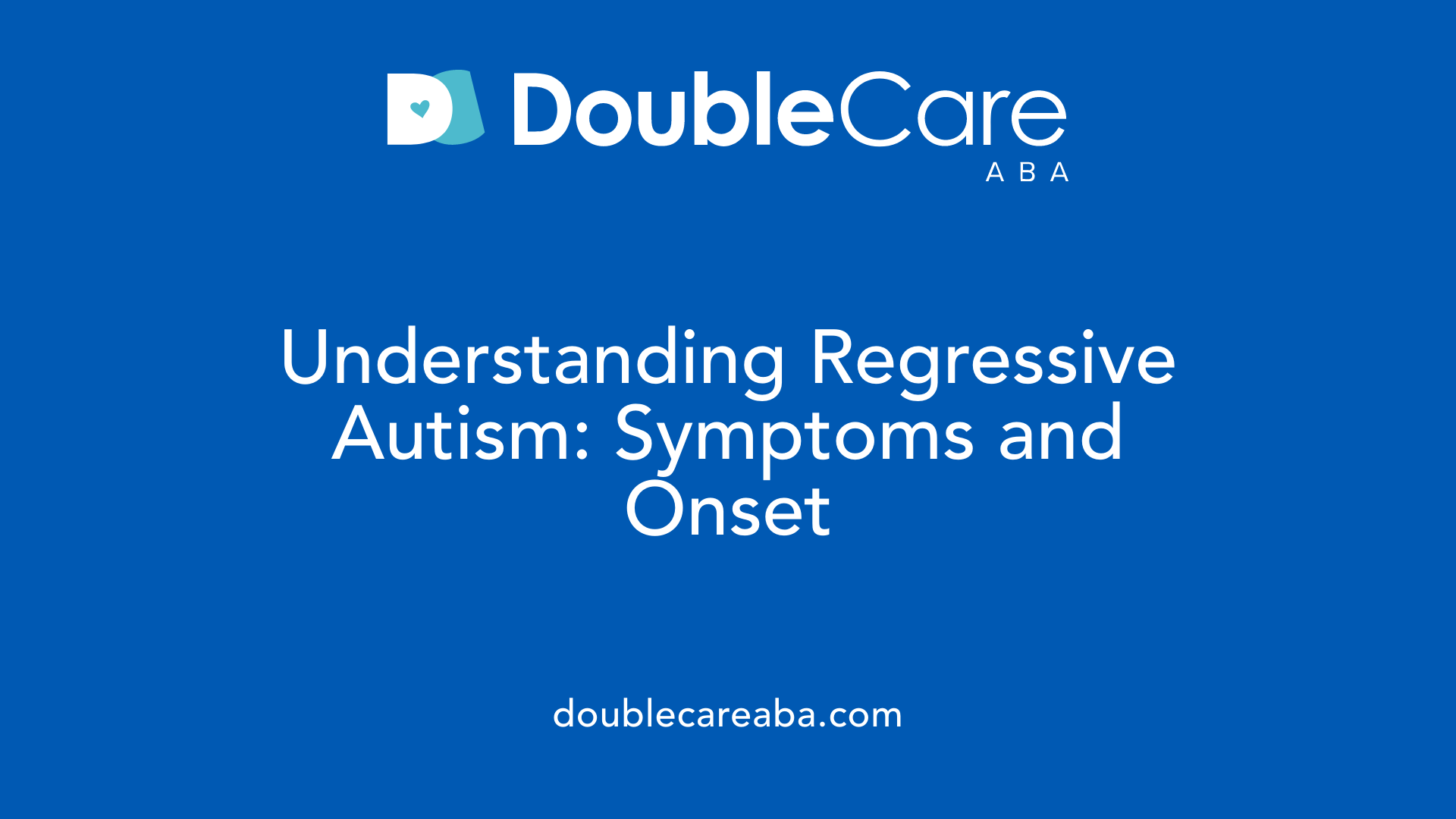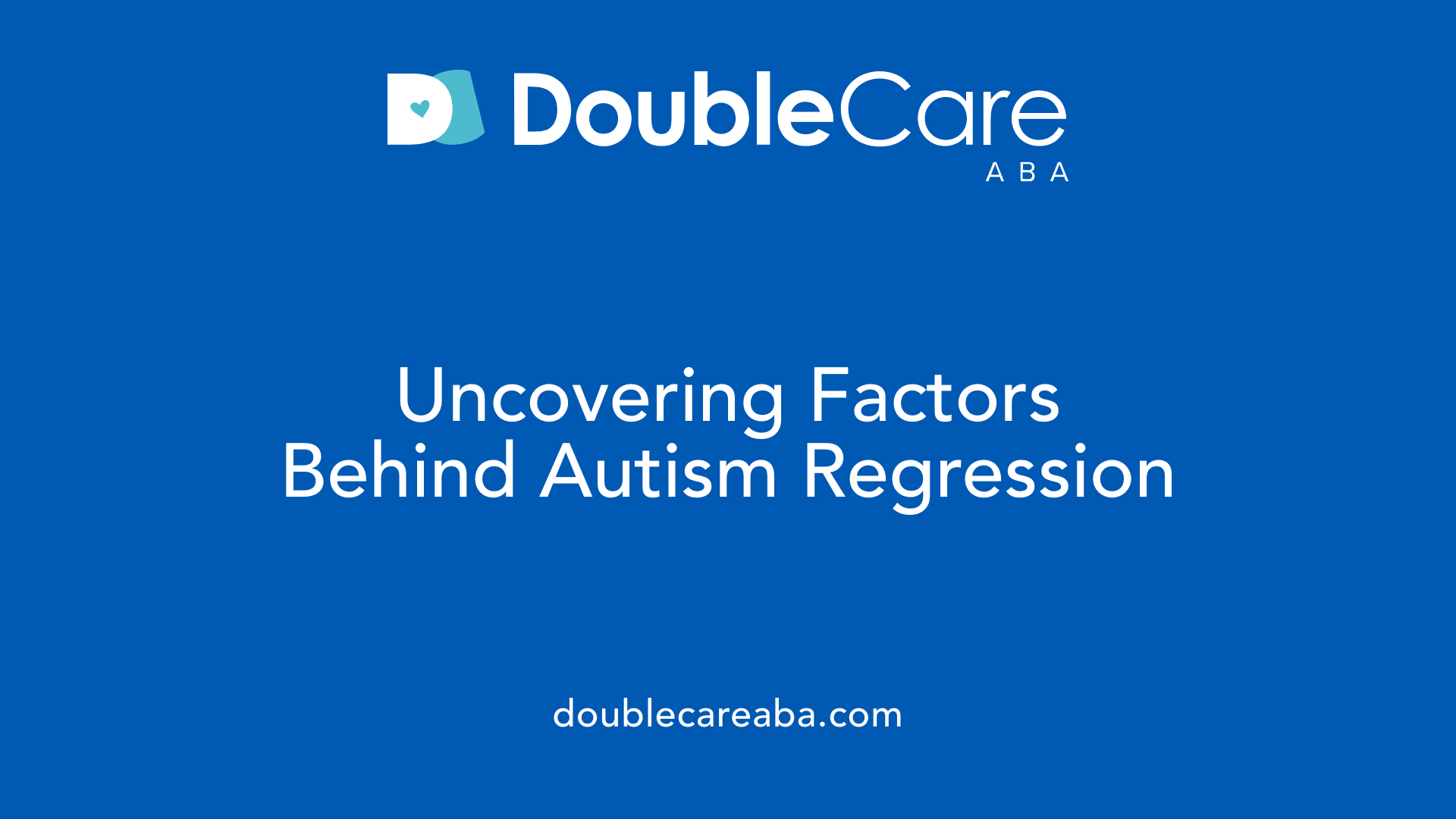How to Address Regression in Autism Development
Tackling Regression in Autism: Early Strategies and Comprehensive Support

Understanding Regression in Autism Development
Autism spectrum disorder (ASD) is marked by diverse developmental trajectories, and one challenging aspect many families face is regressive autism. This form of autism involves the troubling loss of previously acquired skills such as language, social interaction, and motor abilities, typically emerging between 15 and 30 months of age. Understanding how to identify, address, and support regression in autism is critical to improving outcomes for affected children. This article explores the nature of regressive autism, possible causes, intervention strategies including behavioral analysis therapy, and the roles of families and professionals in supporting development and recovery.
What Is Regressive Autism and How Does It Manifest?

Definition of regressive autism
Regressive autism is a form of autism spectrum disorder where a child loses developmental skills they had previously acquired. This typically affects communication, social interaction, emotional regulation, and motor abilities.
Typical age of onset
Regression usually begins between 15 and 30 months of age, with studies indicating an average onset around 19 months. It most commonly occurs in preschool-aged children.
Types of skills lost
Children experiencing regression often lose language skills, including both spoken words and nonverbal forms of communication such as gestures, eye contact, and responding to their name. Social skills and motor functions may also decline.
Signs of regression
Common indicators include a noticeable reduction in speech, decreased communication overall, social withdrawal, less eye contact, and a loss of interest in interacting with peers. These signs reflect a reversal or loss of earlier developmental milestones.
What characterizes regressive autism in young children?
Regressive autism is characterized by a marked loss of previously gained skills, especially in language and social domains. The regression is often sudden or gradual and usually begins around 15 to 30 months old. Affected children typically show decreases in verbal and nonverbal communication, diminished social engagement, and reduced emotional responsiveness.
Biological and Environmental Factors Contributing to Regression

What Genetic Influences Are Associated with Regression?
Genetic factors play a significant role in regressive autism. These influences can predispose children to developmental setbacks, especially when combined with other biological or environmental triggers. Genes related to brain development and immune function often intersect in autism regression, suggesting a complex hereditary component.
How Do Immune System Irregularities Affect Regression?
Immune dysfunction is strongly linked to regressive autism. Autoimmune responses and the presence of autoantibodies targeting brain proteins may trigger or worsen skill loss. This immune irregularity can disrupt normal neural communication, leading to regression in language, social, and motor abilities.
What Role Does Mitochondrial Dysfunction Play?
Mitochondrial energy production issues are implicated in some cases of regression. Since mitochondria provide essential energy for brain cells, dysfunction can lead to impaired neurological function and loss of previously acquired skills. This biological factor highlights the importance of cellular health in autism progression.
How Do Prenatal Factors Contribute to Regression?
Prenatal influences, such as the transfer of maternal antibodies crossing into the fetal brain, are another possible contributor. These antibodies might affect brain development adversely, setting the stage for later regression. Environmental exposures during pregnancy can also compound these effects.
What Are the Gastrointestinal and Brain Structural Influences?
Emerging research points to gastrointestinal inflammation and structural brain abnormalities as linked to autism regression. Physical health challenges, including digestive issues, may influence neurological development and exacerbate symptoms. Structural brain changes observed in some children correlate with more severe regression and support needs.
This multifaceted interplay of genetics, immunity, cellular function, prenatal environment, and physical health underscores why early detection and specifically tailored interventions are essential in managing regressive autism effectively.
The Importance of Early Detection and Intervention

Why is early identification important?
Detecting regressive autism early is crucial because it allows for timely intervention, which significantly improves long-term outcomes. When signs of skill loss are recognized promptly, therapies can be started during a critical developmental window, enhancing communication, social skills, and overall functioning.
How does early intervention affect outcomes?
Starting interventions early, especially before or right after regression begins (often around 19 months), helps children regain lost abilities and develop new skills. Applied Behavior Analysis (ABA), speech therapy, and sensory integration therapies show the greatest benefit when initiated early. These approaches can reduce the severity of symptoms and support better neurocognitive development.
What signs should prompt evaluation?
Parents and caregivers should watch for noticeable losses in language, gestures, eye contact, response to name, social withdrawal, or reduced interaction with peers. These regressions may signal the need for a professional evaluation to confirm regressive autism and begin appropriate support.
What is the role of developmental monitoring?
Regular developmental monitoring ensures that any signs of delayed or regressive milestones are caught early. Healthcare providers and caregivers collaborate to track communication, motor skills, and social engagement milestones, allowing swift referral for further services when concerns arise. This proactive approach underpins successful intervention strategies and better developmental trajectories.
Applied Behavior Analysis (ABA): Core Principles and Application

What is behavioral analysis therapy and how is it used to support individuals with autism?
Behavioral analysis therapy, specifically Applied Behavior Analysis (ABA), is a scientifically supported approach designed to improve communication, social skills, and daily functioning in individuals with autism. ABA relies on evidence-backed techniques to promote positive behaviors and reduce challenging ones through structured, personalized programs.
Definition and science behind ABA
ABA involves using behavioral principles such as positive reinforcement — rewarding desired behaviors to encourage their recurrence — as well as prompting to guide individuals toward new skills. These strategies are rooted in learning theory and the systematic observation and measurement of behavior.
Use of evidence-backed techniques
Qualified professionals, like Board Certified Behavior Analysts (BCBAs), develop individualized treatment plans. These incorporate methods such as discrete trial training, naturalistic teaching, and skill generalization, all supported by extensive research demonstrating their benefits.
Role of positive reinforcement and prompting
Positive reinforcement strengthens communication and social interactions by acknowledging progress. Prompting helps learners acquire new abilities by providing cues or assistance, gradually faded as independence grows.
Structure of ABA sessions
ABA sessions are typically intensive and structured, involving one-on-one interactions that can range from 20 to 40 hours per week. Progress is closely monitored through continuous data collection and evaluations, often with active family involvement to reinforce skills beyond therapy settings.
Early intervention advantages
Starting ABA early—ideally around age 2—maximizes effectiveness, especially for children showing regression or developmental delays. Early intervention facilitates better long-term outcomes in language, cognitive functioning, and adaptive behavior.
Overall, ABA represents a gold-standard, comprehensive behavioral therapy that can be tailored to the unique needs of each individual affected by autism.
Who Provides Behavioral Analysis Therapy?

Who typically provides behavioral analysis therapy for autism?
Behavioral analysis therapy for autism is primarily provided by trained professionals known as behavior analysts. These specialists often hold certifications such as Board-Certified Behavior Analyst (BCBA) or Board Certified Assistant Behavior Analyst (BCaBA), credentials regulated by the Behavior Analyst Certification Board (BACB). Their expertise allows them to design individualized intervention plans centered on Applied Behavior Analysis (ABA), a method that uses evidence-based strategies to encourage positive behaviors and decrease challenging ones.
Role and qualifications of behavior analysts
Behavior analysts possess advanced training in behavior principles, psychological assessment, and intervention techniques. They conduct detailed assessments and continuously monitor progress to adjust treatment plans effectively. The combination of scientific knowledge and practical skills qualifies them to offer tailored therapies that address the specific needs of children with autism, including those experiencing skill regression.
Collaboration with therapists and families
Effective intervention involves a team approach. Behavior analysts collaborate closely with therapists from related disciplines, such as speech-language pathologists and occupational therapists, to ensure comprehensive care that addresses communication, social, sensory, and motor challenges. Family involvement is also crucial; parents and caregivers are trained to support therapy goals at home, fostering consistency and generalization of skills.
Certification and ongoing education
Maintaining certification requires behavior analysts to engage in continuing education and adhere to ethical guidelines. This lifelong learning ensures providers stay updated on the latest research findings, therapeutic innovations, and best practices in autism intervention.
Team-based approach to intervention
Beyond behavior analysts, a multidisciplinary team often includes autism specialists, therapists, educators, and medical professionals. Together, they create an integrated support system tailored to the individual’s developmental profile, maximizing outcomes through collaborative planning and implementation.
Structuring an Effective Behavioral Analysis Therapy Program
How is a behavioral analysis therapy program typically structured for someone with autism?
A behavioral analysis therapy program for autism begins with a thorough assessment, commonly a Functional Behavior Assessment (FBA). This process identifies the reasons behind specific behaviors, helping therapists understand the child's needs and challenges.
Following assessment, therapists create a personalized treatment plan. This plan targets improving communication, social skills, and self-care abilities, while aiming to decrease behaviors that hinder progress. The goals are set to be realistic and measurable, tailored to each child’s developmental profile.
The program breaks down skills into small, manageable steps using techniques like Discrete Trial Training (DTT), which provides structured and repetitive teaching, or Naturalistic Teaching Strategies that incorporate learning in everyday environments for better generalization.
Data collection is continuous during these sessions. Therapists record progress meticulously to monitor effectiveness. If necessary, the program is adjusted based on this data to optimize outcomes.
An essential element is family involvement and training. Families receive education and coaching to reinforce skills at home, ensuring consistency and enhancing the child's ability to apply new behaviors across settings.
Together, these components form a structured, responsive, and collaborative therapy program aimed at supporting children with autism, including those experiencing regression, to regain and develop vital skills.
Complementary Therapies Supporting Communication and Sensory Processing
Speech Therapy and Communication Aids
Speech therapy plays a vital role in helping children with regressive autism redevelop and enhance communication skills. Techniques include traditional speech exercises and alternative communication methods such as sign language and the Picture Exchange Communication System (PECS). PECS enables nonverbal children to express needs and ideas through picture cards, fostering early communication and reducing frustration.
Sensory Integration Therapy
Many children with regressive autism experience sensory processing challenges affecting tactile (touch), vestibular (balance), and proprioceptive (body position) senses. Sensory integration therapy aims to help individuals better interpret and respond to sensory information. This therapy uses structured activities designed to improve sensory modulation and promote more adaptive responses to everyday sensory inputs.
Auditory Interventions: Berard and Tomatis Methods
Auditory therapies focus on managing sound sensitivity and improving auditory processing. Berard Auditory Integration Training exposes children to modulated music to reduce hypersensitivity to sound. Similarly, the Tomatis method uses electronically altered music and vocal exercises to enhance auditory attention, listening, and communication abilities. Both approaches seek to improve language comprehension and reduce auditory defensiveness commonly seen in regressive autism.
Vision Therapies: Irlen Lenses and Vision Training
Visual challenges such as poor tracking, attention difficulties, and light sensitivity can interfere with learning and social interaction. Vision training involves exercises to strengthen eye coordination and processing. Irlen lenses, specially tinted glasses, are used to reduce visual stress and improve comfort by filtering out problematic light wavelengths. These therapies support better visual performance and engagement in daily activities.
These complementary therapies, when integrated with behavioral and medical interventions, contribute significantly to addressing the varied communication and sensory processing needs of children experiencing regressive autism.
Family-Centered and Social Relationship Interventions
What is Relationship Development Intervention (RDI)?
Relationship Development Intervention (RDI) is a family-based approach aimed at enhancing social skills and emotional regulation in children with autism, particularly those experiencing regression. RDI focuses on strengthening relationships by starting with parent training to foster child development through everyday interactions.
Why is Parental Training Important?
Parental training is central to RDI because it equips parents with strategies to support their child's social engagement and communication within familiar environments. Empowered parents can better recognize and respond to their child’s needs, promoting meaningful connections and reducing stress.
How Does This Approach Improve Social Skills and Emotional Regulation?
RDI targets the development of social communication by encouraging joint attention, flexible thinking, and emotional understanding. By emphasizing interactive experiences, children learn to manage emotions, interpret social cues, and build lasting relationships.
What Role Does Stress Management and Coping Skill Development Play?
Regression and autism-related challenges can increase stress for both children and families. Incorporating stress management techniques and fostering new coping skills are vital components of intervention. These help reduce burnout, support emotional resilience, and facilitate the reacquisition of lost skills or adaptation to changes.
By focusing on family-centered strategies like RDI, families create supportive environments that nurture social growth and emotional well-being, crucial for children with regressive autism to thrive.
Medical Approaches and Their Role in Addressing Regression
What Are the Benefits of Steroid Therapies in Regressive Autism?
Steroid therapies have shown potential benefits for children experiencing regressive autism, particularly in improving language skills and overall neurological function. These treatments may help reduce inflammation or immune-related attacks in the brain that contribute to skill loss, thereby possibly aiding recovery or slowing regression.
What Are the Potential Side Effects and Why Is Medical Supervision Important?
Steroid therapies are not without risks. Possible side effects can include weight gain, mood swings, increased susceptibility to infections, and hormonal imbalances. Due to these risks, it is essential that steroid treatment be administered under strict medical supervision to carefully monitor and manage any adverse effects.
How Are Immune Dysfunction and Mitochondrial Issues Linked to Regression?
Research indicates that immune system irregularities, such as autoimmunity and autoantibodies targeting brain proteins, may trigger or worsen regression. Additionally, mitochondrial dysfunction — which affects cellular energy production — is another biological factor linked to regression in autism. Both immune dysregulation and mitochondrial problems contribute to neurological impairments often observed during regression.
What Are the Current Directions in Research?
Current studies are focused on understanding the complex biological underpinnings of autism regression, particularly immune dysregulation and mitochondrial dysfunction. This research aims to identify specific mechanisms that cause regression to develop more targeted and effective therapies. Investigations into immune-related pathways and energy metabolism in brain cells hold promise for future medical interventions tailored to individual needs.
These medical approaches emphasize the importance of early diagnosis and personalized treatment plans. While behavioral and developmental therapies remain foundational, integrating medical treatments under careful supervision could enhance outcomes for children experiencing regression in autism.
Understanding the Impact of Autistic Burnout and Stress on Regression
What is autistic burnout and how is it characterized?
Autistic burnout refers to a state of chronic stress and severe exhaustion experienced by autistic individuals when their coping reserves are depleted. It is marked by increased difficulties in managing sensory issues, cognitive overload, and emotional regulation. This burnout often results in a loss or worsening of previously mastered skills, making daily functioning more challenging.
How does autistic burnout relate to regression and skill loss?
Autistic burnout is closely linked to regression, where individuals experience a significant reversal of skills such as communication, social interaction, and emotional regulation. Particularly in adults, regression can occur due to sustained stress, overwhelming environments, or mental health struggles. These factors may cause previously acquired abilities to diminish temporarily or persistently.
What strategies help manage chronic stress to prevent or reduce burnout?
Managing chronic stress involves adopting techniques that support emotional well-being and resilience. Key strategies include:
- Establishing structured routines to reduce unpredictability.
- Developing new coping skills tailored to sensory and social challenges.
- Engaging in relaxation practices such as mindfulness or gentle physical activity.
- Seeking professional support, including therapy focused on stress management.
How can support systems and adaptations assist individuals experiencing burnout?
Strong support networks are essential. Family-based interventions and relationship-focused therapies can enhance understanding and communication. Modifying environments to reduce sensory overload—such as dim lighting or noise reduction—and providing educational accommodations help individuals regain stability. Support groups and mental health services contribute to long-term coping and recovery from regression related to burnout.
Concluding Insights and Moving Forward
Why is early intervention important in regressive autism?
Early detection and intervention are crucial for improving outcomes in children with regressive autism. Since regression usually happens between 15 and 30 months, often around 19 months, timely support can help regain lost skills and reduce the impact of more severe core symptoms. Behavioral therapies like Applied Behavior Analysis (ABA) and speech therapy started at this stage are especially effective in developing communication and social skills.
How should interventions be tailored to address the complexity of regressive autism?
Interventions need to be personalized, considering the wide range of biological and behavioral factors involved. For example, some children benefit from sensory integration therapy for tactile and vestibular challenges, while others need auditory and vision therapy to address processing and attention issues. Additionally, biological contributors such as mitochondrial dysfunction, immune system irregularities, and gastrointestinal inflammation should be considered when designing treatment plans. Steroid therapies may be an option under medical supervision for some children.
What role does collaboration play in managing regressive autism?
Effective intervention relies on strong collaboration among families, therapists, and medical professionals. Family-based approaches like Relationship Development Intervention (RDI) empower parents to support their children’s social development. Regular communication ensures therapies are consistently adjusted to the child’s evolving needs and encourages a holistic approach.
How does ongoing research offer hope for the future?
Current research exploring immune dysregulation, mitochondrial dysfunction, and neurological factors is expanding understanding of autism regression. This knowledge is paving the way for innovative therapies tailored to individual biological causes. Combined with early detection and comprehensive, tailored interventions, the future offers hopeful prospects for improving quality of life and developmental outcomes for children with regressive autism.
Conclusion: Empowering Families and Therapeutic Teams
Addressing regression in autism development requires a comprehensive understanding of its multifaceted nature, including biological, environmental, and emotional contributors. Early detection combined with intensive, evidence-based behavioral therapies like Applied Behavior Analysis can markedly improve outcomes. Complementing ABA with speech, sensory, and social therapies—and considering medical interventions when appropriate—creates a holistic approach tailored to each individual’s needs. Family involvement is essential for sustaining gains and supporting emotional well-being. As research advances our knowledge of regression mechanisms, the possibilities for innovative treatments expand, offering new hope to families and professionals committed to nurturing growth despite regression's challenges.















